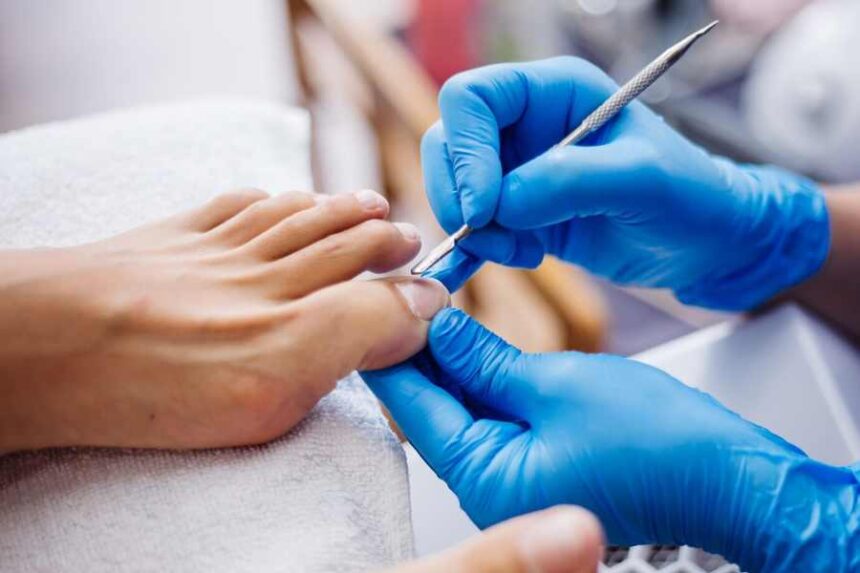After undergoing ingrown toenail surgery, it’s important to follow a proper recovery plan to ensure a smooth and quick healing process. Ingrown toenails occur when the edges of a toenail grow into the skin, causing pain, swelling, and sometimes infection.
- 1. Keep the Area Clean and Dry
- 2. Use Antibiotic Ointment
- 3. Elevate the Foot
- 4. Take Over-the-Counter Pain Relievers
- 5. Wear Loose, Comfortable Footwear
- 6. Change the Bandages Regularly
- 7. Avoid Strenuous Activity
- 8. Soak the Toe in Saltwater
- 9. Monitor for Signs of Infection
- Heal with Care, Recover with Comfort!
Surgery to treat this condition involves removing part of the toenail or the surrounding tissue. While professional care is necessary, this article provides nine several home treatments tips that you can follow in order to speed up the healing and reduce the discomfort.
1. Keep the Area Clean and Dry
The first and most important step after surgery is to keep the affected area clean. Gently wash the toe with mild soap and warm water to remove any dirt or bacteria. Be sure to pat the area dry with a clean towel afterward. Keeping the area dry helps prevent infections, which can slow down the healing process. Furthermore, avoid soaking the toe in water until your doctor gives you permission to do so.
2. Use Antibiotic Ointment
Take note that after cleaning the surgical site, applying an antibiotic ointment can help prevent infection. These ointments create a protective barrier against bacteria and promote faster healing. Apply a thin layer of the ointment on the wound, and cover it with a clean bandage. Furthermore, always make sure that you follow your doctor’s instructions regarding the use of any specific ointments or creams.
3. Elevate the Foot
Swelling is common after ingrown toenail surgery. Elevating your foot can help reduce swelling and improve circulation to the area. When resting, prop your foot up on a pillow to keep it elevated above the level of your heart. With this simple trick, you can help minimize discomfort and speed up recovery. Try to do this as often as possible, especially during the first few days after surgery.
4. Take Over-the-Counter Pain Relievers
To manage the pain, over-the-counter pain relievers like ibuprofen or acetaminophen can be helpful. These medications not only reduce pain but also help reduce inflammation, which can speed up healing. Always follow the dosage instructions on the label or as prescribed by your doctor. Plus, avoid taking medications if you have any known allergies or conditions that might interact with your ingrown surgery.
5. Wear Loose, Comfortable Footwear
Wearing tight shoes can irritate the surgical site and slow down healing after your ingrown toenail surgery. That’s why it is important to wear shoes that are roomy and comfortable. Avoid shoes that put pressure on the toe, such as high heels or narrow shoes. You should choose soft, breathable shoes with a wide toe box, or even open-toed shoes, to prevent friction and allow the area to heal properly.
6. Change the Bandages Regularly
In order for you to prevent infection and ensure that the area is healing properly, change the bandages regularly. Ideally, you should change the dressing at least once a day or whenever it becomes wet or dirty. Use sterile bandages and gauze to cover the surgical site. In addition to that, clean the area before applying fresh bandages, and avoid touching the wound with dirty hands to reduce the risk of infection.
7. Avoid Strenuous Activity
While it may be tempting to get back to your normal activities, it’s important to rest during the initial recovery period. Engaging in strenuous activities or putting excessive pressure on the foot can disrupt the healing process and cause pain. Also, avoid running or prolonged standing for a few weeks after surgery. Don’t forget to allow your toe to heal properly before resuming your usual activities.
8. Soak the Toe in Saltwater
Once your doctor clears you to soak the toe, a warm saltwater soak is a great way to promote healing. The saltwater helps reduce swelling, kill bacteria, and soothe the area. To make a saltwater soak, mix about one teaspoon of salt in a bowl of warm water. Soak the toe for 10-15 minutes once or twice a day. However, if you notice any increase in pain or swelling, stop the soaks and contact your doctor.
9. Monitor for Signs of Infection
Don’t forget that while the healing process is usually straightforward, it’s important to watch for signs of infection, which can delay recovery. If you notice increased redness or warmth around the surgical site, it indicates an infection. Additional signs include pus drainage or a fever. But, if you notice that you have any of these symptoms that occur, contact your healthcare provider immediately for further treatment.
Heal with Care, Recover with Comfort!
Recovery after ingrown toenail surgery can take time, but with proper care, you can heal quickly and comfortably. By keeping the area clean, using antibiotics as needed, and following the other home treatments mentioned above, you can minimize pain, prevent infection, and support the healing process.
Always consult with your doctor if you have concerns or notice any signs of complications. By taking the right steps at home, you can get back to your daily routine without discomfort. Remember, the healing process is different, and it’s important to listen to your body and give it the time it needs to recover.




